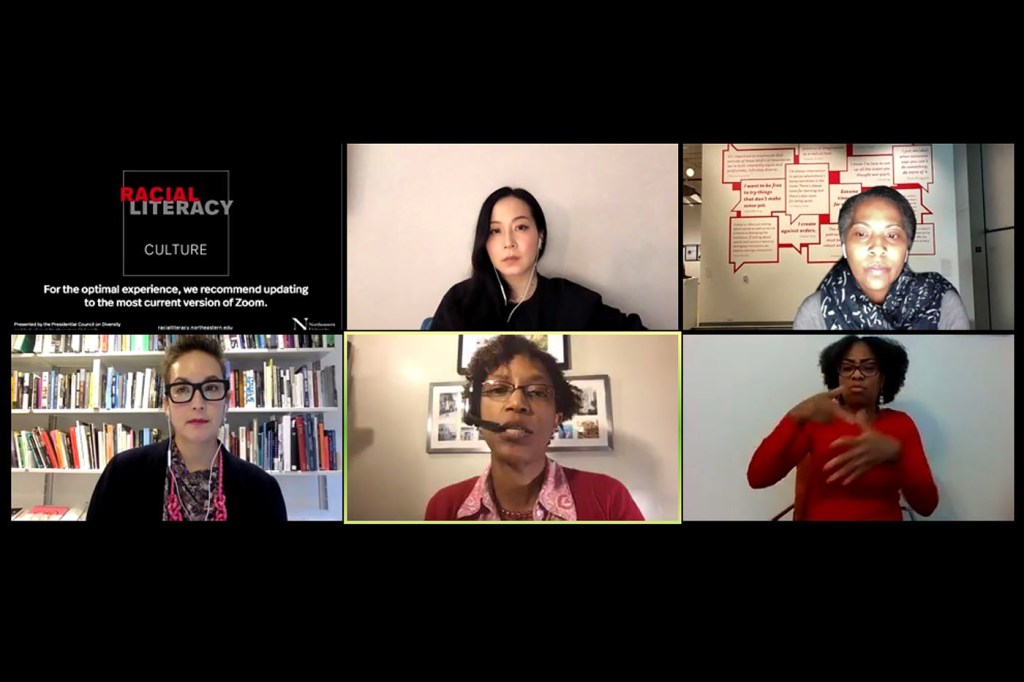Changing culture is the first step toward erasing racial boundaries

Culture is more than what we watch, read, and listen to. The movies, TV shows, theater, books, music, and podcasts we consume shape our understanding of ourselves and the world in which we live, according to a panel of Northeastern faculty who spoke during the third installment of the university’s Racial Literacy series.
And in the United States, where boundaries have been drawn along racial, gender, and class lines, they said, understanding how the culture both reflects and reinforces those boundaries is key to erasing them.
Our culture can serve to reinforce harmful stereotypes—or build understanding for new ways of relating to each other, said Nicole Aljoe, an associate professor of English and Africana studies who moderated the virtual discussion on Tuesday. But if we want to bring lasting change to society, she said, changing the culture is just as important as changing the law.
Aljoe, who is also director of the Africana Studies Program, offered an example from the height of the Civil Rights era in the U.S. The 1968 film Planet of the Apes has been interpreted by scholars to be an allegory for race, and one that “represents Black power as threatening to white people.”
The movie premiered just four years after the passage of the Civil Rights Act, which banned segregation in public places as well as discrimination on the basis of race, color, religion, sex or national origin. It was the absence of a cultural shift, to accompany that legislative shift, that set the stage for the movie, Aljoe said.
“It’s not enough to ‘create diversity,’” she said. “Just adding more people will not change the system; we must completely change the rules to achieve racial equity.”
Aljoe was one of four faculty members who took part in this third installment of the Racial Literacy series, which is sponsored by the President’s Council on Diversity and Inclusion. Uta Poiger, dean of the College of Social Sciences and Humanities, and James Hackney, dean of the Law School, chair the council.
Culture plays a large part in our perception of ourselves and the way we fit into the broader world, said Melissa Pearson, assistant teaching professor in English and another of the panelists on Tuesday.
Pearson, who is Irish, Native American, and African, discussed how she came to understand herself through her own lived experiences. She recounted the different ways she and a white friend—both eight years old at the time—were treated by their families after a day of suntanning. And she recalled the depictions of Black people—“always poor, but poor and happy”—in the TV shows she watched growing up in the 1970s and ’80s.
“Rarely did the programs reinforce solidarity or pride with connection to my culture or racial identity,” she said.
It wasn’t until reading Black feminist literature in college that she found “stories of girls and women being unapologetically Black; courageous and smart,” Pearson said, and the discovery changed her life.
“I understand now how deeply rooted internalized oppression can be, and how I act within that oppression,” Pearson said. “Black feminism helped me rise above my fragmented heritage to understand that there are no single stories, and there are multiple ways to understand familial love. I could love myself even if the world told me not to.”
Often, culture is used to define and contextualize each other’s differences, said Gloria Sutton, assistant professor of contemporary art history. In her own experience as an American who has a white father and a South Korean mother, Sutton says she’s “read as Asian” in Europe, but “didn’t count as a minority” in her undergraduate experience stateside.
This contextual reading of race affects not just Sutton’s own life, but filters out into every aspect of culture. Artists can be designated as minorities by art galleries, and then only shown in exhibitions that cater to “minority audiences,” a feedback loop that only reinforces “conformism and forms of erasure,” she said.
Culture, therefore, “is not a passive site of consumption, but an active site of power,” said Eunsong Kim, assistant professor of English and cultures.
Kim recalled reading books by white authors throughout her childhood, and often having to point out to teachers and professors how thoroughly white the casts or authors were in their assigned reading.
“The education of culture was not and continues not to be built with many of us in mind,” she said Tuesday. “The power of colonization is transmitted through education.”
The works that were—and still are—considered canon largely reinforced a white, Euro-centric narrative, Kim said. And, echoing Aljoe, she added, “Inclusion and visibility are not enough if the structures behind them remain the same.”
For media inquiries, please contact media@northeastern.edu.





